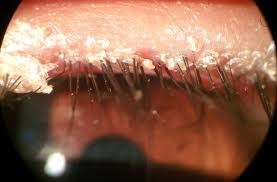Blepharitis

Blepharitis is the name given to inflammation of the eyelids. No one knows quite why it occurs but the tiny oil glands (Meibomian glands) which are responsible for producing a silky, oily layer to the tears become clogged. In turn this leads to dry eyes.
How is it diagnosed?
It usually affects both eyes along the margins of the eyelids that become red, swollen and crusty. Blepharitis is closely associated with dry eyes.
Anyone can get blepharitis but it tends to be more common in the over 50s and those who suffer from psoriasis, dandruff or dermatitis. It is not a sign of being unhygienic.
What are the treatments?
Whilst it may be uncomfortable at times, blepharitis can be easily managed with self-help hygiene measures. Blepharitis rarely causes serious eye damage.
The treatment involves daily washing of the eyelids followed by gentle massaging of the lid margins for 30 seconds.
To wash your eyelids, soak some clean cottonwool in a specially designed cleaning solution which can be applied to your eyelids (lid cleaning products can be bought from pharmacies and opticians).
Prior to lid massage, gently press a warm flannel on the lid margins (for between 5-10 minutes). This will help to melt/loosen the oily contents of the glands (which can be likened to candle wax).
Once melted, the lids can be massaged.
Lid massage:
Use your index finger or middle finger and sweep the pad of that finger from the inner corner of the eye lid to the outer corner, just resting on the eyelid above the eye lashes (for the upper lid) and just resting below the lashes (for the lower lid). Massage the upper lid first, followed by lower lid. Massage for 30 seconds.
Blepharitis is not infectious but it will usually require ongoing management.
Useful websites
- Moorfields Eye Hospital: Blepharitis
https://www.moorfields.nhs.uk/condition/blepharitis-0